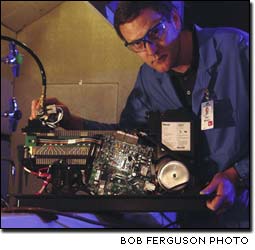|
Fuel
cells in the air
 Imagine you're outdoors at a busy airport with jetliners dotting its
flight line. But something is different. The hiss of auxiliary power
units (APUs) is gone. Instead, a whisper from the tail of the nearest
jet tells you a fuel cell is providing clean, quiet, and efficient power
for the airplane while it's on the ground. Imagine you're outdoors at a busy airport with jetliners dotting its
flight line. But something is different. The hiss of auxiliary power
units (APUs) is gone. Instead, a whisper from the tail of the nearest
jet tells you a fuel cell is providing clean, quiet, and efficient power
for the airplane while it's on the ground.
Boeing engineers are working to realize this tantalizing vision, which
is just one of many fuel cell initiatives today being pursued across
the company. Fuel cells are devices that convert the chemical energy
of fuel and oxygen into electrical energy without combustion. They are
extremely clean, highly efficient, and inherently reliable because the
fuel cell stack itself has no moving parts. When fueled with pure hydrogen,
fuel cells emit only pure water and warm air as exhaust. When hydrocarbon
fuels are substituted, they have far lower emission levels than combustion
engines.
FULL STORY >>

International fuel cell efforts include
Boeing
A quiet, pollution-free, electric airplane might soon take to the skies.
Experts at Boeing Research and Technology Europe in Madrid, Spain, are
working on a project called the Fuel Cell Demonstrator Airplane. This
multinational program is providing Boeing people with invaluable firsthand
experience in fuel cells and their application
to aviation.
BR&TE was formed in July 2002 as a center of excellence in environmental,
safety and reliability, and air traffic management technologies. A part
of Boeing Phantom Works, the Madrid center collaborates with industry,
academia, and other centers of research across the European continent.
FULL STORY >>

Fuel
cells to keep UAVs aloft
U.S. military forces and government agencies today need unmanned aerial
vehicles (UAVs) with long endurances aloft to conduct extended surveillance
and reconnaissance missions. However, this capability does not yet exist,
and surveillance satellites cannot make up the shortfall because their
continuing orbits do not allow constant focus on an area of interest.
To meet this emerging requirement, engineers at the Advanced Unmanned
Systems unit of Phantom Works' Integrated Defense Advanced Systems (IDeAS)
organization are currently integrating fuel cells into Boeing UAV designs.
This approach uses cryogenically stored liquid hydrogen to power the
aircraft's onboard fuel cell.
FULL STORY >>
|

